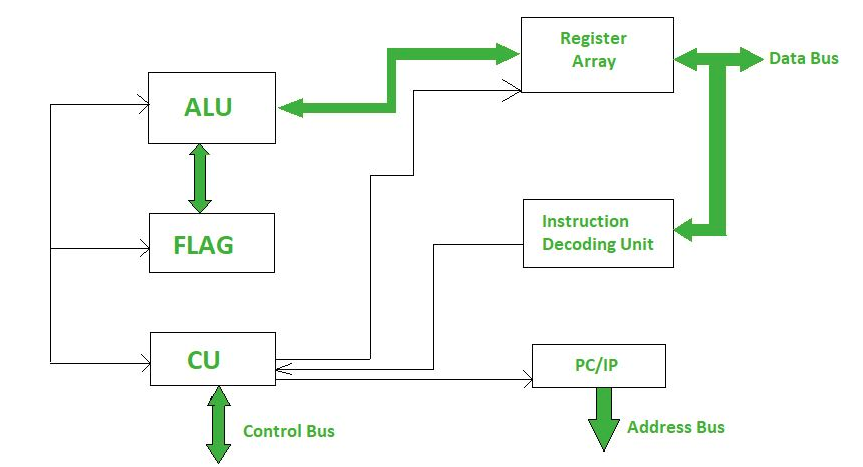Introduction of Microprocessor
Last Updated :
22 Jul, 2021
A Microprocessor is an important part of a computer architecture without which you will not be able to perform anything on your computer. It is a programmable device that takes in input performs some arithmetic and logical operations over it and produces the desired output. In simple words, a Microprocessor is a digital device on a chip that can fetch instructions from memory, decode and execute them and give results.
Basics of Microprocessor –
A Microprocessor takes a bunch of instructions in machine language and executes them, telling the processor what it has to do. Microprocessor performs three basic things while executing the instruction:
- It performs some basic operations like addition, subtraction, multiplication, division, and some logical operations using its Arithmetic and Logical Unit (ALU). New Microprocessors also perform operations on floating-point numbers also.
- Data in microprocessors can move from one location to another.
- It has a Program Counter (PC) register that stores the address of the next instruction based on the value of the PC, Microprocessor jumps from one location to another and takes decisions.
A typical Microprocessor structure looks like this.

Clock Speed of different Microprocessor:
8086: 4.7MHz, 8MHz, 10MHz
8088: more than 5MHz
80186/80188: 6MHz
80286: 8MHz
INTEL 80386: 16MHz to 33MHz
INTEL 80486: 16MHz to 100MHz
PENTIUM: 66MHz
INTEL CORE-2: 1.2GHz to 3GHz
INTEL i7: 66GHz to 3.33GHz
INTEL i5: 2.4GHz to 3.6GHz
INTEL i3: 2.93GHz to 3.33GHz
We do not have any 128-bit Microprocessor at work at present one of the reasons for this is that we are a long way from exhausting the 64-bit address space itself, we use it at a constant rate of roughly 2 bits every 3 years. At present we have only used 48 bits of 64 bits so why require 128-bit address space. Also, 128-bit Microprocessor would be much slower than the 64 bit Microprocessor.
Types of Processor:
- Complex Instruction Set Computer (CISC) –
CISC or Complex Instruction Set Computer is a computer architecture where instructions are such that a single instruction can execute multiple low-level operations like loading from memory, storing into memory, or an arithmetic operation, etc. It has multiple addressing nodes within a single instruction.CISC makes use of very few registers.
Example:
1. Intel 386
2. Intel 486
3. Pentium
4. Pentium Pro
5. Pentium II
6. Pentium III
7. Motorola 68000
8. Motorola 68020
9. Motorola 68040 etc.
- Reduced Instruction Set Computer (RISC) –
RISC or Reduced Instruction Set Computer is a computer architecture where instruction is simple and designed to get executed quickly. Instructions get completed in one clock cycle this is because of the optimization of instructions and pipelining (a technique that allows for simultaneous execution of parts, or stages, of instructions more efficiently process instructions). RISC makes use of multiple registers to avoid large interactions with memory. It has few addressing nodes.
Example:
1. IBM RS6000
2. MC88100
3. DEC Alpha 21064
4. DEC Alpha 21164
5. DEC Alpha 21264
- Explicitly Parallel Instruction Computing (EPIC) –
EPIC or Explicitly Parallel Instruction Computing permits computers to execute instructions parallel using compilers. It allows complex instructions execution without using higher clock frequencies.EPIC encodes its instruction into 128-bit bundles. each bundle contains three instructions which are encoded in 41 bits each and a 5-bit template field(contains information about types of instructions in a bundle and which instructions can be executed in parallel).
Example:
1. IA-64 (Intel Architecture-64)
Share your thoughts in the comments
Please Login to comment...